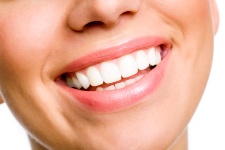 Head to the pharmacy and stroll down the toothpaste aisle and you’ll find an entire section devoted to teeth-whitening products. People want to have white teeth, just like the movie stars or like we did when we were young. We start out with white teeth as children, but as we get older and our adult teeth grow, there is a discernible yellowish hue to those once pearly whites. By the time we are 50, our teeth start to yellow in earnest.
Head to the pharmacy and stroll down the toothpaste aisle and you’ll find an entire section devoted to teeth-whitening products. People want to have white teeth, just like the movie stars or like we did when we were young. We start out with white teeth as children, but as we get older and our adult teeth grow, there is a discernible yellowish hue to those once pearly whites. By the time we are 50, our teeth start to yellow in earnest.
What causes this change in color? The yellowing of teeth is partly triggered by changes in mineral structure. Your tooth enamel becomes less porous. The enamel then becomes more susceptible to picking up stains from the foods you eat, such as tea, coffee, tobacco, wine, and cola. Even mouthwash can color the teeth if it contains a chemical called chlorhexidine. Another cause of tooth yellowing is the use of tetracylines, a commonly prescribed antibacterial medication.
It’s no wonder people turn to teeth-whitening agents. But what do these teeth-whitening gels contain and are they good for you? Usually there is some form of peroxide: either hydrogen or carbamide. There is some evidence that these substances cause lesions in the teeth when used over a long period of time.
For example, one clinical trial looked at the effects of hydrogen peroxide, carbamide peroxide and sodium bicarbonate on human tooth enamel. The researchers tested two popular whitening products, “Rembrandt” and “Mentadent” along with “Colgate” toothpaste with added baking soda. They used scanning electron microscopy (SEM) to discover if any lesions appeared on the enamel surface—and they did. The SEM showed different types of lesions of varying severity, with hydrogen peroxide causing the worst lesions.
If you would like to try some natural teeth whiteners, here are seven that can be made at home:
1. Baking Soda
Baking soda can be used as a natural teeth whitener. The one thing to remember about baking soda is that it’s moderately abrasive. You can use it two or three times a week but everyday use is discouraged as it may cause enamel damage over the long term. When brushing with baking soda, use gentle, circular motions.
2. Strawberry Pulp
Crush some strawberries and brush the pulp onto your teeth. Leave it there for five minutes. Rinse away the pulp and floss if you need to and voila! Your teeth should look whiter.
3. Malic Acid
Malic acid (which is found in strawberries by the way) can be used occasionally to whiten the teeth naturally. Like baking soda though, it too is somewhat abrasive and is not for “everyday” whitening. Use this natural teeth whitener sporadically.
4. Green Apples
Green apples help to scrub your teeth clean when you bite through the peel and flesh of the apple repeatedly. Green apples also contain malic acid. Have one every afternoon for a snack to keep your teeth enamel clean.
5. Carrots
Carrots are another great snack for cleaning your teeth, helping them look brighter and whiter. Take the time to crunch on one or two after lunch.
6. Celery
Celery is one more great snack for naturally cleaning your teeth. Space out your natural teeth-whitening regimen by eating celery sticks, carrots, and apples throughout the day.
7. Lemon Juice
Squeeze some lemon juice on your teeth and gently brush them. One note of caution: lemon juice is acidic and needs to be rinsed completely from your teeth as soon as you’re finished brushing otherwise you may damage your tooth enamel.
Instead of using expensive teeth whitening products, these seven natural teeth whiteners can work just as effectively—and chances are you already have them at home.
Source(s) for Today’s Article:
Silva, L.R., et al., “In vitro study on tooth enamel lesions related to whitening dentifrice,” Indian J Dent Res. November-December 2011; 22(6): 770-6.
“Teeth Whitening,” The Canadian Dental Association web site; http://www.cda-adc.ca/en/oral_health/procedures/teeth_whitening/, last accessed July 16, 2013.
Stephens, A., “The truth about tooth whitening,” The Daily Mail web site; http://www.dailymail.co.uk/health/article-113670/The-truth-tooth-whitening.html, last accessed July 16, 2013.
